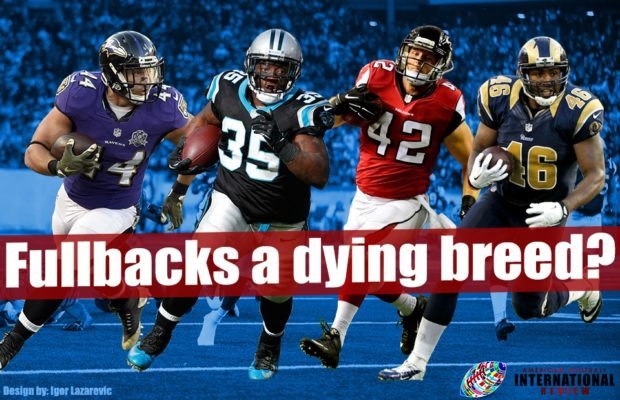Many people seem to think that the position of fullback is an outdated concept. Fullbacks, it seems, have become a dying breed. They are perceived to simply take up a position on the field which could be better filled by a slot receiver or a tight end. After all, the NFL is a pass first system, and so surely giving the quarterback another receiver to aim for, or more time to pass would make sense? Many people may well agree with this opinion. However, though statistically fullbacks may not seem to be the greatest contributors to a teams, when utilised effectively, they can be integral to a team’s success.
Only four fullbacks in NFL
In order to truly appraise the value of a fullback, only the contributions of those which have been utilised to a reasonable extent can be taken into account. If we are to take the value of 30% of offensive snaps as a benchmark for a fully utilised fullback, then the number of players left is reduced to four: Carolina’s Mike Tolbert, Baltimore’s Kyle Juszczyk, Atlanta’s Patrick DiMarco and Los Angeles’ Cory Harkey (who, despite converting to tight end, was listed as a fullback throughout the 2015 regular season).
Measuring value of fullbacks
The first, and most obvious contribution an offensive player can make is in yardage gained. This is often the basis of the main criticism of fullbacks, as they rarely have the breakaway speed to consistently make long runs and often aren’t involved in gaining yards whatsoever. This can be seen with both Juszczyk and DiMarco, who had a combined three rushing attempts in the whole of the 2015 regular season.
However, when fullbacks are utilised as alternate runners, then they can be extremely effective, with Mike Tolbert rushing for 256 yards on the year. Moreover, their main use as rushers comes from their ability to convert on short yardage situations, and this can again be seen with Tolbert, who converted over 70% of the 3rd down situations in which he was involved. Furthermore, in week four of the 2016 season John Kuhn, fullback for the New Orleans Saints, scored three touchdowns, two from one yard out. Thus, fullbacks can clearly be seen to have value in this regard alone.
Stats don’t tell everything
Moreover, another facet of a fullback’s game, which doesn’t show up on the stats sheets, but helps their teams immeasurably, is their run blocking. Fullbacks who can block effectively allow their running back partners to excel, with them being able to isolate linebackers in a way which a slot-receivers are rarely able. This ability to improve their running backs can be clearly seen with three of the four running backs who ran behind these highly utilised fullbacks making the Pro Bowl, with the only exception being Justin Forsett, who spent six games out with injury. This clearly shows that fullbacks can create effective rushing lanes and vastly improve their team’s rushing attack.
The NFL is currently a pass orientated league, and fullbacks are seen as relics of a bygone era when this was not the case. Indeed, defences are now being orientated towards speed, rather than size and coverage linebackers are seemingly more highly coveted than ‘big-bodied thumpers’. This can clearly be seen in the most recent draft, with Myles Jack’s coverage skills placing him above Reggie Ragland in terms of desirability, despite his injury.
This makes it even more important that fullbacks are retained in the NFL, as with this transition towards speedier, less powerful linebackers and safeties, larger fullbacks will increasingly have an easier time making holes for a running back once they get to the second level.
This is why, although the position of fullback would seem to have been relegated to a status of lesser importance, giving up on it altogether would not be a wise idea. Just ask the Panthers, Ravens, Falcons or Rams.
In other words, the day of the fullback is far from over.

